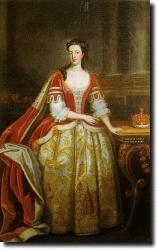|
| |
 | |
|
Elizabeth Hervey, Lady Bristol, to
her husband John, the first Earl of
Bristol 29th April 1736. (Right): Elizabeth Hervey, (Ickworth House, courtesy of National Trust.)  (Above): Taken from a map engraved by Collins, c. 1760. Lord Bristol's reply, 8th May 1736: Lord Bristol to his wife, Elizabeth,
15th May 1736:  (Above): Augustus John, 3rd Earl of Bristol, by Sir Joshua Reynolds, 1762.  (Above): Memorial plaque from Cairo Cathedral, It reads: |
The Manor House was built between 1736 and 1738 for Elizabeth Hervey (1676-1741), second wife of John Hervey, first Earl of Bristol whose main residence was at Ickworth, some three miles away. Elizabeth was the daughter of Sir Thomas Felton of Playford, who was a Member of Parliament at different times for both Orford and Bury St. Edmunds, and Master of the Household. The family was a distinguished one, but Elizabeth was Sir Thomas's only child and heiress. When she married John Hervey, the name Felton became extinct. John Hervey, first Earl of Bristol (1665-175 1) was one of Bury St. Edmunds' M.P.s from 1694-1703 when he was created Baron Hervey of Ickworth. In 1714 he was created Earl of Bristol.  The architect of the Manor House was Mr. (later Sir) James Burrough (1692-1764), the son of a local physician. In 1754 he became Master of Gonville and Caius College in Cambridge. A distinguished antiquary and amateur architect, his other works included the New Building at Peterhouse and the Chapel of Clare College, both at Cambridge. On 25th September 1738 Lord and Lady Bristol spent their first night at the Manor House. Lady Bristol enjoyed her new home for less than three years. In 1741 she died and bequeathed the house to her husband for the term of his natural life, then to their youngest son, Felton, and then to his descendants. Each person who inherited the house had to sign an inventory of the goods inside and be accountable for them 'that so the goods etc. may from time to time go along with my said house and premises as heirlooms and as belonging thereunto.' If any of them refused to sign, they would not receive the house. In addition, they all had to add Felton, Elizabeth's maiden name, to their christian names 'in remembrance of my family'. This is presumably because the Felton name had become extinct upon her marriage and Elizabeth wished to have it perpetuated. It seems that she viewed the Manor House as a memorial to her family, but. it remained a Bristol property only until around 1780.  It was built in classical Palladian style, following the strict principles of proportion and symmetry that owed their origins to ancient Greek and Roman architecture. This style was extremely fashionable, and all that a rich and powerful family would wish for in a modern home of the earlier eighteenth century. Like similar houses at this time, it was designed and built to entertain and impress guests Although we cannot be certain how the house looked or was used, we can make an educated guess based upon surviving evidence and contemporary accounts from elsewhere. From the entrance hall, a visitor to the house on business (generally in the mornings) may have been taken to the Library, and an afternoon dinner guest to the Dining Room. Upstairs, in the Ballroom or 'Salon' evening entertainment would have been provided for family and friends. Next to it, the Withdrawing Room was for more intimate guests, with the only Bedroom adjoining. A network of narrow stairs, little connecting lobbies and corridors gave the servants easy access to these public areas, although the kitchens were in the much older timber-framed property next door!  The Manor House had a succession of owners after the Hervey family. In the nineteenth century, there are several references to its being used as judges' lodgings during the Assizes. This gave rise to the alternative name 'The Court House', by which the Manor House was known for many years. The best known owner of later years is Walter Edward Guinness, the first Baron Moyne (1880-1944), who owned the house from 1908-1933. He was M.P. for Bury St. Edmunds from 1907-1931 and in 1932 was raised to the peerage as Baron Moyne of Bury St. Edmunds. The first Lord Moyne had a distinguished military and political career; he was Minister of Agriculture, and finally British Government representative in Cairo, where he was assassinated in 1944. His elder son was the author Bryan Guinness, who married Diana Mitford in 1929. She is known to have stayed in the Manor House in that year. They were divorced in 1933 and Diana married Sir Oswald Mosley, the founder of the British Union of Fascists In 1947, West Suffolk County Council bought the house and used it as offices. In 1985 it was bought by Bristol Estates. Finally, St. Edmundsbury Borough Council bought the house in 1988 and, after restoration, it was opened as a museum in January 1993. Today, some aspects of this long and fascinating story are displayed in the museum. For example, several portraits of the Bristol family are displayed on the staircase, including a portrait of the first Earl, John Hervey. Another fine portrait is that of Augustus John. 3rd Earl of Bristol (1724-1779) by Sir Joshua Reynolds. Finally, links to the twentieth century are found with the memorial plaque to the first Lord Moyne. This had been in Cairo Cathedral from after the time of his death in 1944 until the demolition of the cathedral in recent years. Now it hangs appropriately enough where the person it commemorates once lived and worked, and helps bring to a close the story of the Manor House as a family home. |
